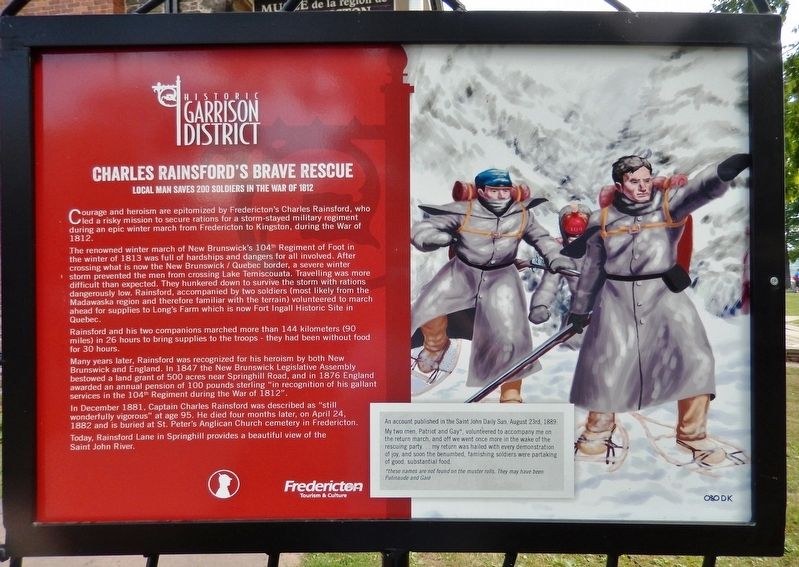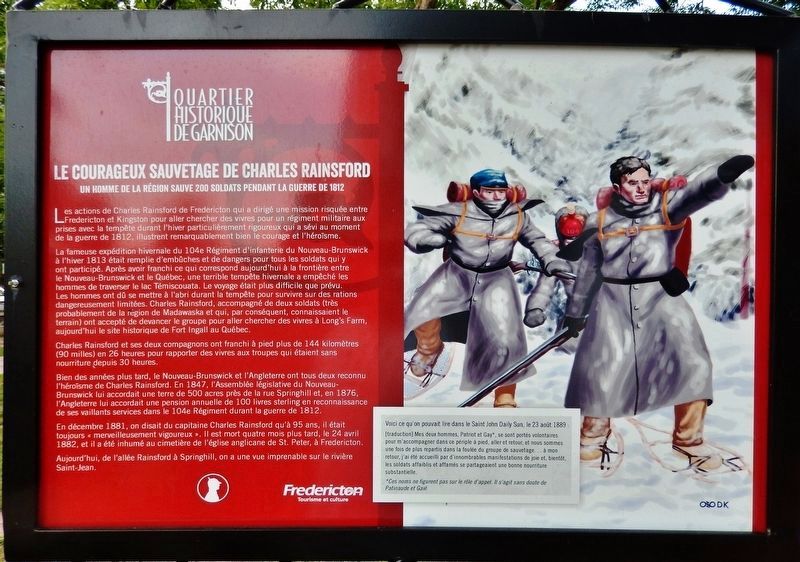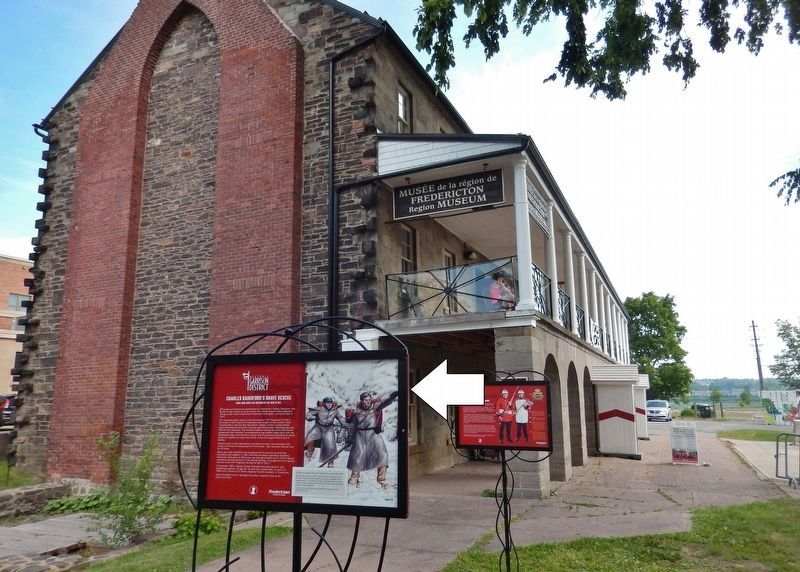Fredericton in York County, New Brunswick — The Atlantic Provinces (North America)
Charles Rainsford's Brave Rescue
Courageux Sauvetage de Charles Rainsford
Local Man Saves 200 Soldiers in the War of 1812
Courage and heroism are epitomized by Fredericton's Charles Rainsford, who led a risky mission to secure rations for a storm-stayed military regiment during an epic winter march from Fredericton to Kingston, during the War of 1812.
The renowned winter march of New Brunswick's 104th Regiment of Foot in the winter of 1813 was full of hardships and dangers for all involved. After crossing what is now the New Brunswick / Quebec border, a severe winter storm prevented the men from crossing Lake Temiscouata. Travelling was more difficult than expected. They hunkered down to survive the storm with rations dangerously low. Rainsford, accompanied by two soldiers (most likely from the Madawaska region and therefore familiar with the terrain) volunteered to march ahead for supplies to Long's Farm which is now Fort Ingall Historic Site in Quebec.
Rainsford and his two companions marched more than 144 kilometers (90 miles) in 26 hours to bring supplies to the troops - they had been without food for 30 hours.
Many years later, Rainsford was recognized for his heroism by both New Brunswick and England. In 1847 the New Brunswick Legislative Assembly bestowed a land grant of 500 acres near Springhill Road, and in 1876 England awarded an annual pension of 100 pounds sterling "in recognition of his gallant services in the 104th Regiment during the War of 1812".
In December 1881, Captain Charles Rainsford was described as "still wonderfully vigorous" at age 95. He died four months later, on April 24, 1882 and is buried at St. Peter's Anglican Church cemetery in Fredericton.
Today, Rainsford Lane in Springhill provides a beautiful view of the Saint John River.
An account published in the Saint John Daily Sun, August 23rd, 1889:
My two men, Patriot and Gay*, volunteered to accompany me on the return march, and off we went once more in the wake of the rescuing party. . . my return was hailed with every demonstration of joy, and soon the benumbed, famishing soldiers were partaking of good, substantial food.
*these names are not found on the muster rolls. They may have been Patinaude and Gaié
Un homme de la région sauve 200 soldats pendant la guerre de 1812
Les actions de Charles Rainsford de Fredericton qui a dirigé une mission risquée entre Fredericton et Kingston pour aller chercher des vivres pour un régiment militaire aux prises avec la tempête
durant l'hiver particulièrement rigoureux qui a sévi au moment de la guerre de 1812, illustrent remarquablement bien le courage et l'héroïsme.
La fameuse expédition hivernale du 104e Régiment d'infanterie du Nouveau-Brunswick à l'hiver 1813 était remplie d'embûches et de dangers pour tous les soldats qui y ont participé. Après avoir franchi ce qui correspond aujourd'hui à la frontière entre le Nouveau-Brunswick et le Québec, une terrible tempête hivernale a empêché les hommes de traverser le lac Témiscouata. Le voyage était plus difficile que prévu. Les hommes ont dû se mettre à l'abri durant la tempête pour survivre sur des rations dangereusement limitées. Charles Rainsford, accompagné de deux soldats (très probablement de la région de Madawaska et qui, par conséquent, connaissaient le terrain) ont accepté de devancer le groupe pour aller chercher des vivres à Long's Farm, aujourd'hui le site historique de Fort Ingall au Québec.
Charles Rainsford et ses deux compagnons ont franchi à pied plus de 144 kilomètres (90 milles) en 26 heures pour rapporter des vivres aux troupes qui étaient sans nourriture depuis 30 heures.
Bien des années plus tard, le Nouveau-Brunswick et l'Angleterre ont tous deux reconnu l'héroïsme de Charles Rainsford. En 1847, l'Assemblée législative du Nouveau-Brunswick lui accordait une terre de 500 acres près de la rue Springhill et, en
1876, l'Angleterre lui accordait une pension annuelle de 100 livres sterling en reconnaissance de ses vaillants services dans le 104e Régiment durant la guerre de 1812.
En décembre 1881, on disait du capitaine Charles Rainsford qu'à 95 ans, il était toujours « merveilleusement vigoureux ». Il est mort quatre mois plus tard, le 24 avril 1882, et il a été inhumé au cimetière de l'église anglicane de St. Peter, à Fredericton.
Aujourd'hui, de l'allée Rainsford à Springhill, on a une vue imprenable sur le rivière Saint-Jean.
Voici ce qu'on pouvait lire dans le Saint John Daily Sun, le 23 août 1889 :
[traduction] Mes deux hommes, Patriot et Gay*, se sont portés volontaires pour m'accompagner dans ce périple à pied, aller et retour, et nous sommes une fois de plus repartis dans la foulée du groupe de sauvetage. . . à mon retour, j'ai été accueilli par d'innombrables manifestations de joie et, bientôt, les soldats affaiblis et affamés se partageaient une bonne nourriture substantielle.
*Ces noms ne figurent pas sur le rôle d'appel. Il s'agit sans doute de Patinaude et Gaié.
Erected by Fredericton Tourism and Culture/Tourisme et culture de Fredericton.
Topics. This historical marker is listed in these topic lists: Colonial Era • War of 1812. A significant historical year for this entry is 1813.
Location. 45° 57.709′ N, 66° 38.369′ W. Marker is in Fredericton, New Brunswick, in York County. Marker can be reached from Queen Street (New Brunswick Route 102) west of Sainte Anne's Point Drive, on the right when traveling west. Marker is located at the Officers' Square Provincial Heritage site, on the south side of the Fredericton Region Museum. Touch for map. Marker is at or near this postal address: 571 Queen Street, Fredericton NB E3B 5C8, Canada. Touch for directions.
Other nearby markers. At least 8 other markers are within walking distance of this marker. Juliana Horatia (Gatty) Ewing (here, next to this marker); Anatomy of the Guard (here, next to this marker); Birthplace of the Canadian Army (here, next to this marker); Epic Winter March of New Brunswick Soldiers in the War of 1812 (here, next to this marker); New Brunswick's 104th Regiment of Foot (within shouting distance of this marker); The Right Honourable William Maxwell Lord Beaverbrook (within shouting distance of this marker); Fredericton Military Compound / Le Complexe Militaire de Frédéricton (about 120 meters away, measured in a direct line); The 104th Regiment / Le 104e Régiment (about 150 meters away). Touch for a list and map of all markers in Fredericton.
More about this marker. South side of marker in English; north side of marker in French • Côté sud du marqueur en anglais; côté nord du marqueur en français
Related markers. Click here for a list of markers that are related to this marker. New Brunswick's 104th Regiment of Foot
Also see . . .
1. The Rainsford Brothers, War of 1812 Veterans. In July 1806, Charles was commissioned into the 104th Regiment. As a lieutenant in No 6 Company, he showed considerable courage and stamina during the famous 104th winter march. A segment of the regiment became stormed stayed on Lake Temiscouata and ran short of food. Lieutenant Rainsford volunteered to go to Riviere-du-Loup for supplies. He made the round trip of 145 km on snowshoes in 48 hours. (Submitted on July 8, 2020, by Cosmos Mariner of Cape Canaveral, Florida.)
2. In Rainsford’s 1847 petition over compensation for military service he provides a summary of the eve. One of the most noteworthy parts of New Brunswick’s participation in the War of 1812 was the march of the 104th to Upper Canada to support the forces battling the American forces along the Great Lakes. A key event during that march occurred when the troops were stymied by a snow storm near Lake Témiscouata. Charles Rainsford’s recounting of the details of the trek to secure food for the troops is worthy of a Hollywood drama. (Submitted on July 8, 2020, by Cosmos Mariner of Cape Canaveral, Florida.)
Credits. This page was last revised on July 8, 2020. It was originally submitted on July 5, 2020, by Cosmos Mariner of Cape Canaveral, Florida. This page has been viewed 175 times since then and 10 times this year. Photos: 1, 2, 3. submitted on July 8, 2020, by Cosmos Mariner of Cape Canaveral, Florida.


